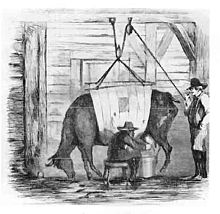
The swill milk scandal was a major adulterated food scandal in the state of New York in the 1850s. The New York Times reported an estimate that in one year 8,000 infants died from swill milk. [1] [2]

The swill milk scandal was a major adulterated food scandal in the state of New York in the 1850s. The New York Times reported an estimate that in one year 8,000 infants died from swill milk. [1] [2]
Swill milk referred to milk from cows fed swill which was residual mash from nearby distilleries. The milk was whitened with plaster of Paris, thickened with starch and eggs, and hued with molasses. [3]
After the extraction of alcohol from the macerated grain, the residual mash still contains nutrients, and therefore it was an economic advantage to keep cows stabled near distilleries and feed them with swill. [1]
As the population of New York City exploded in the antebellum period, a time when safe drinking water was scarce, the demand for milk soared. But as the city expanded, and real estate prices climbed, the meadows necessary to raise hay-fed cattle moved farther from its markets. The cost of bringing fresh milk to customers in the city became prohibitive, and threatened to restrict its supply to relatively wealthy inhabitants. For the same sanitary reasons that made milk popular, alcohol was also consumed at the highest per capita rates in US history, [4] and New York City was home to a large number of distilleries. Distilleries in London had experimented with feeding the waste product of their industry—the fermented mash of rye, barley and wheat commonly referred to as “swill”—to cattle with some success, and New York City distillers soon followed suit. The milk from swill-fed cows, produced in dense urban areas, and often priced as low as 6 cents per quart, was affordable to most of New York City’s poorest residents. [5]
The New York Academy of Medicine carried out an examination and established the connection of swill milk with the increased infant mortality in the city. [6] [7] The topic of swill milk was also well exposed in pamphlets and caricatures of the time.
In May 1858, Frank Leslie's Illustrated Newspaper did a landmark exposé of the distillery-dairies of Manhattan and Brooklyn that marketed so-called swill milk that came from cows fed on distillery waste and then adulterated with water, eggs, flour, and other ingredients that increased the volume and masked the adulteration. [8] Swill milk dairies were noted for their filthy conditions and overpowering stench both caused by the close confinement of hundreds (sometimes thousands) of cows in narrow stalls where, once they were tied, they would stay for the rest of their lives, often standing in their own manure, covered with flies and sores, and suffering from a range of virulent diseases. These cows were fed boiling distillery waste, often leaving the cows with rotting teeth and other maladies. The milk drawn from the cows was routinely adulterated with water, rotten eggs, flour, burnt sugar and other adulterants with the finished product then marketed falsely as "pure country milk" or "Orange County Milk". [9] [10]
In an editorial published at the height of the scandal, the New York Times described swill milk as a "bluish, white compound of true milk, pus and dirty water, which, on standing, deposits a yellowish, brown sediment that is manufactured in the stables attached to large distilleries by running the refuse distillery slops through the udders of dying cows and over the unwashed hands of milkers..." [1]
Frank Leslie's exposé caused widespread public outrage and local politicians were strongly pressured to punish and regulate the distillery-dairies, which were formally complained to be "swill milk nuisance". [11] The Tammany Hall politician Alderman Michael Tuomey, known as "Butcher Mike", defended the distillers vigorously throughout the scandal—in fact, he was put in charge of the Board of Health investigation. Frank Leslie's Illustrated Newspaper staked out distillery owner Bradish Johnson's mansion at 21st and Broadway, and reported that in the midst of the investigation, Tuomey was observed making late night visits. Tuomey assumed a central role in the ensuing investigations, and, with fellow Aldermen E. Harrison Reed and William Tucker, shielded the dairies and turned the hearings into one-sided exercises designed to make dairy critics and established health authorities look ridiculous, even going to the extent of arguing that swill milk was actually as good or better for children than regular milk. [11] With Reed and others, Tuomey successfully blocked any serious inquiry into the dairies and stymied calls for reform. The Board of Health exonerated the distillers, but public outcry led to the passage of the first food safety laws in the form of milk regulations in 1862. [12] Tuomey became known for his attempts to block the new regulations, and earned the new moniker "Swill Milk" Tuomey. [13] In addition to Tuomey's assistance in clearing up the unclean image milk developed, Robert Milham Hartley, a social reformist, aided in the restoration of milk being a nutritional and safe-to-drink beverage. During the mid to late nineteenth century, Hartley utilized Biblical references in his essays to appeal to the urban community. He asserted that universal milk consumption could help alleviate society's "sins", poverty, and alcohol consumption. [14]

Milk is a white liquid food produced by the mammary glands of mammals and the caecilian Siphonops annulatus. It is the primary source of nutrition for young mammals before they are able to digest solid food. Immune factors and immune-modulating components in milk contribute to milk immunity. Early-lactation milk, which is called colostrum, contains antibodies that strengthen the immune system and thus reduce the risk of many diseases. Milk contains many nutrients, including calcium and protein, but also lactose and saturated fat.

Rye whiskey can refer to two different, but related, types of whiskey:

Weaning is the process of gradually introducing an infant human or another mammal to what will be its adult diet while withdrawing the supply of its mother's milk.
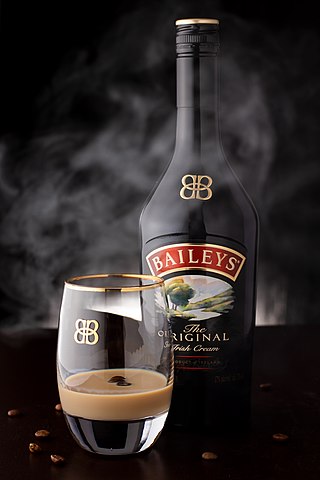
Baileys Irish Cream is an Irish cream liqueur made of cream, cocoa and Irish whiskey emulsified together with vegetable oil. Baileys is made by Diageo at Nangor Road, in Dublin, Ireland and in Mallusk, Northern Ireland. It is the original Irish cream, invented by a team headed by Tom Jago in 1971 for Gilbeys of Ireland; Diageo currently owns the trademark. It has a declared alcohol content of 17% by volume.
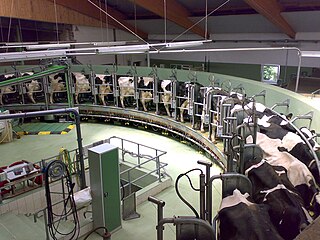
Dairy farming is a class of agriculture for the long-term production of milk, which is processed for the eventual sale of a dairy product. Dairy farming has a history that goes back to the early Neolithic era, around the seventh millennium BC, in many regions of Europe and Africa. Before the 20th century, milking was done by hand on small farms. Beginning in the early 20th century, milking was done in large scale dairy farms with innovations including rotary parlors, the milking pipeline, and automatic milking systems that were commercially developed in the early 1990s.

Melamine is an organic compound with the formula C3H6N6. This white solid is a trimer of cyanamide, with a 1,3,5-triazine skeleton. Like cyanamide, it contains 66% nitrogen by mass, and its derivatives have fire-retardant properties due to its release of nitrogen gas when burned or charred. Melamine can be combined with formaldehyde and other agents to produce melamine resins. Such resins are characteristically durable thermosetting plastic used in high pressure decorative laminates such as Formica, melamine dinnerware including cooking utensils, plates, plastic products, laminate flooring, and dry erase boards. Melamine foam is used as insulation, soundproofing material and in polymeric cleaning products, such as Magic Eraser.

Eggnog, historically also known as a milk punch or an egg milk punch when alcoholic beverages are added, is a rich, chilled, sweetened, dairy-based beverage. It is traditionally made with milk, cream, sugar, egg yolks, and whipped egg whites. A distilled spirit such as brandy, rum, whiskey or bourbon is often a key ingredient.

Jim Beam is an American brand of bourbon whiskey produced in Clermont, Kentucky, by Beam Suntory. It is one of the best-selling brands of bourbon in the world. Since 1795, seven generations of the Beam family have been involved in whiskey production for the company that produces the brand. The brand name became "Jim Beam" in 1943 in honor of James B. Beam, who rebuilt the business after Prohibition ended. Previously produced by the Beam family and later owned by the Fortune Brands holding company, the brand was purchased by Suntory Holdings in 2014.
An adulterant is caused by the act of adulteration, a practice of secretly mixing a substance with another. Typical substances that are adulterated include but are not limited to food, cosmetics, pharmaceuticals, fuel, or other chemicals, that compromise the safety or effectiveness of the said substance.

A milk substitute is any substance that resembles milk and can be used in the same ways as milk. Such substances may be variously known as non-dairy beverage, nut milk, grain milk, legume milk, mock milk and alternative milk.
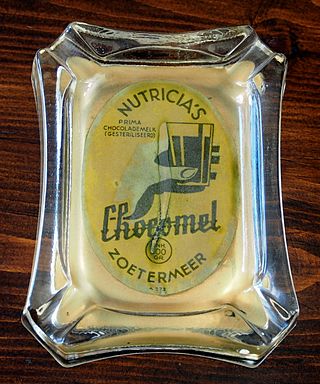
Nutricia is a Danone brand that specialises in therapeutic food and infant formula, including medical nutrition for babies with specific needs.
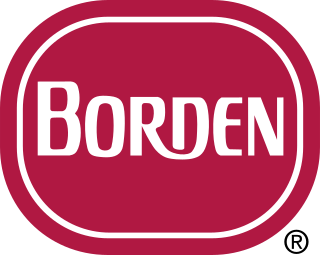
Borden, Inc., was an American producer of food and beverage products, consumer products, and industrial products. At one time, the company was the largest U.S. producer of dairy and pasta products. Its food division, Borden Foods, was based in Columbus, Ohio, and focused primarily on pasta and pasta sauces, bakery products, snacks, processed cheese, jams and jellies, and ice cream. It was best known for its Borden Ice Cream, Meadow Gold milk, Creamette pasta, and Borden Condensed Milk brands. Its consumer products and industrial segment marketed wallpaper, adhesives, plastics and resins. By 1993, sales of food products accounted for 67 percent of its revenue. It was also known for its Elmer's and Krazy Glue brands.
Michael Tuomey (1819–1887), was a nineteenth-century New York City civil servant and politician.
In China, the adulteration and contamination of several food and feed ingredients with inexpensive melamine and other compounds, such as cyanuric acid, ammeline and ammelide, are common practice. These adulterants can be used to inflate the apparent protein content of products, so that inexpensive ingredients can pass for more expensive, concentrated proteins. Melamine by itself has not been thought to be very toxic to animals or humans except possibly in very high concentrations, but the combination of melamine and cyanuric acid has been implicated in kidney failure. Reports that cyanuric acid may be an independently and potentially widely used adulterant in China have heightened concerns for both animal and human health.
Sanlu Group CO., Ltd. (SJZSGCZ) was a Chinese dairy products company based in Xinhua District, Shijiazhuang, the capital city of Hebei. It produced one of the oldest and most popular brands of infant formula in China. New Zealand's Fonterra owned 43% of Sanlu.

The 2008 Chinese milk scandal was a significant food safety incident in China. The scandal involved Sanlu Group's milk and infant formula along with other food materials and components being adulterated with the chemical melamine, which resulted in kidney stones and other kidney damage in infants. The chemical was used to increase the nitrogen content of diluted milk, giving it the appearance of higher protein content in order to pass quality control testing. 300,000 affected children were identified, among which 54,000 were hospitalized, according to the latest report in January 2009. The deaths of six babies were officially concluded to be related to the contaminated milk.

Bradish Johnson was an American industrialist and slave owner. He owned plantations and sugar refineries in Louisiana and a large distillery in New York City. In 1858 his distillery was at the heart of a scandal when an exposé in a weekly magazine accused it of producing altered and unsafe milk, called "swill milk", for sale to the public. The swill milk scandal helped to create the demand for consumer protection laws in the United States.
Dairy is a significant part of the agricultural output of New York state. New York ranks forth out of the fifty states in dairy production. The state's nearly 4,000 dairy farms annually produce over 15 billion pounds of milk.